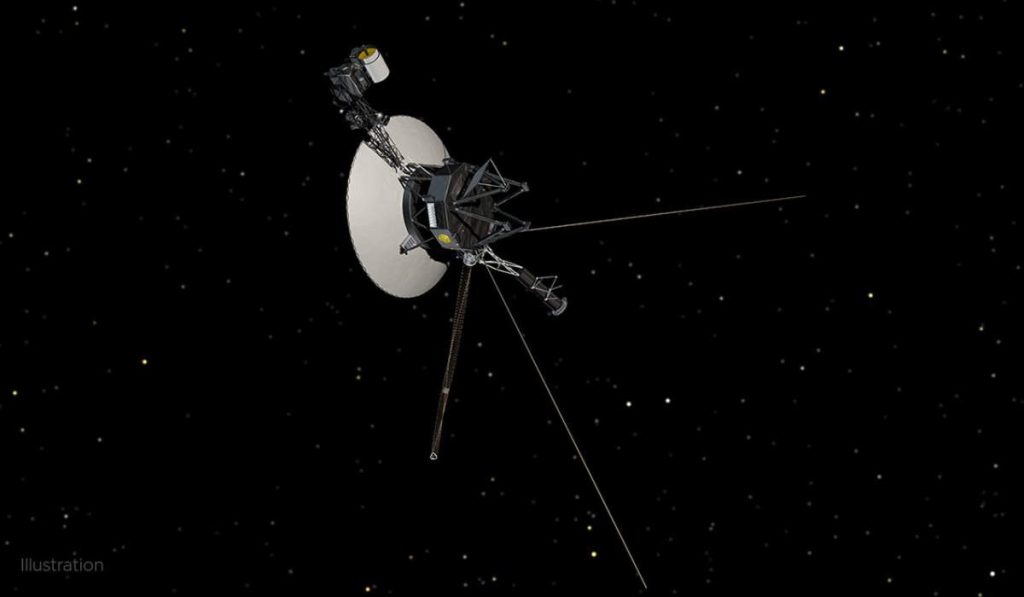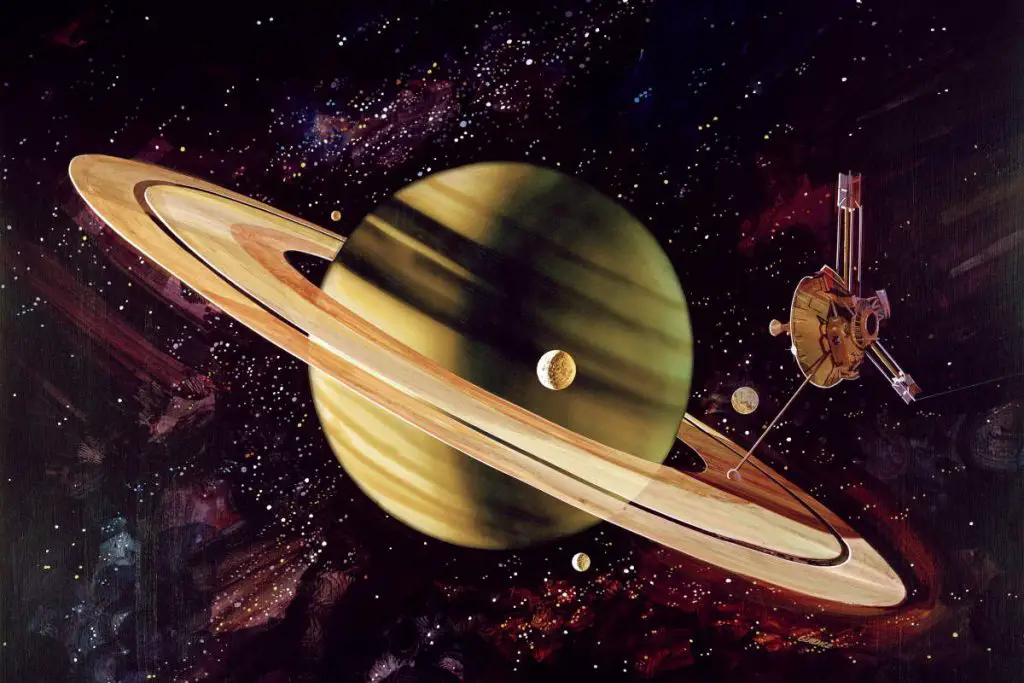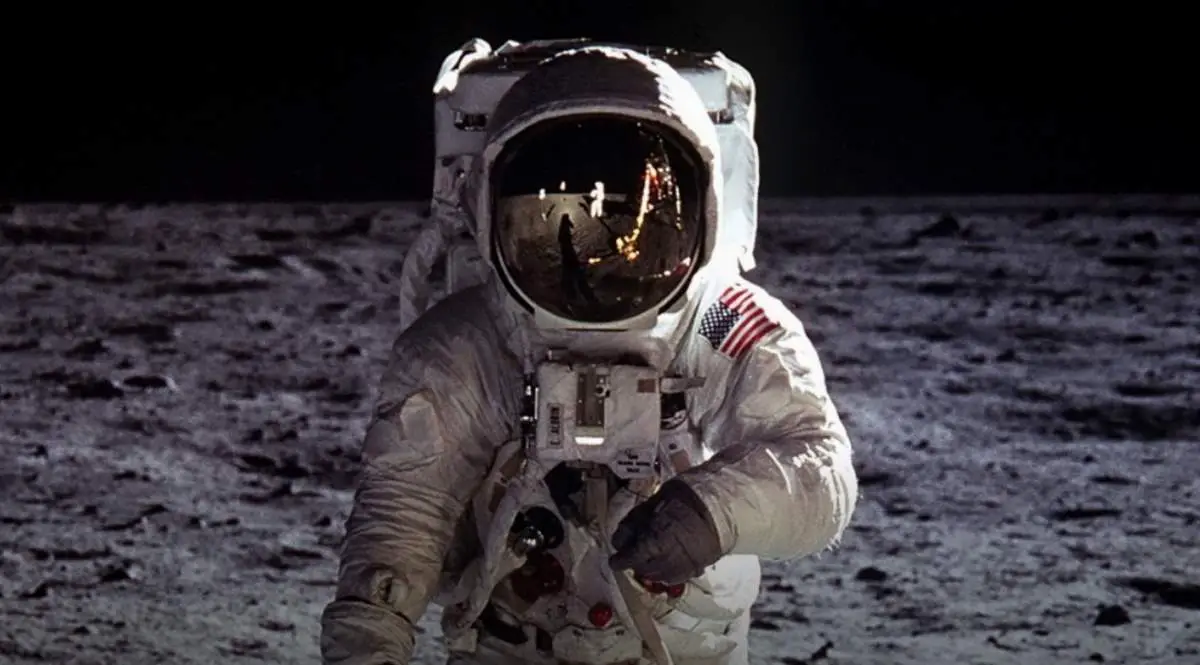The budget of NASA from 1970 to 1979 marks a decade of transition and continued exploration in space science. Building on the success of the Moon landing, this period saw the development and execution of significant missions such as the Viking landings on Mars, the launch of Skylab, America’s first space station, and the inception of the Space Shuttle program. The funding during these years played a vital role in maintaining America’s leadership in space exploration and technology. In this article, we will examine the year-by-year budget of NASA that enabled these groundbreaking achievements and shaped the direction of human spaceflight and planetary exploration.
Main Article: The budget of NASA from 1958 to 2024 [year by year]
The budget of NASA from 1970 to 1979 [year by year]
The numbers in square brackets [] are the budget of NASA adjusted for inflation (2023 equivalent).
1970: $3.752 billion [$29.437 billion]
The budget of NASA is 1.92% of the 1970 Fed Budget
Major achievements:
- April 11-17: Apollo 13 mission. It was the seventh crewed mission in NASA’s Apollo space program. It was intended to be the third to land on the moon, but an oxygen tank explosion in the service module resulted in a critical failure en route. The accident occurred on April 13, 1970, when astronauts James Lovell (born March 25, 1928), Jack Swigert (August 30, 1931 – December 27, 1982), and Fred Haise (born November 14, 1933) were about 200,000 miles (322,000 km) from Earth. Despite the dangerous situation, the crew and mission control worked together to safely return the astronauts to Earth on April 17. The phrase “Houston, we’ve had a problem” is famously associated with the Apollo 13 mission. This mission marked a “successful failure“ due to the safe return of the astronauts amid a life-threatening crisis.
1971: $3.382 billion [$25.444 billion]
The budget of NASA is 1.61% of the 1971 Fed Budget
Major achievements:
- January 31-February 9: Apollo 14, the third U.S. lunar landing mission, and the first since the near disaster of Apollo 13 took place. It was crewed by astronauts Alan Shepard (November 18, 1923 – July 21, 1998), Stuart Roosa (August 16, 1933 – December 12, 1994), and Edgar Mitchell (September 17, 1930 – February 4, 2016) on board. Shepard and Mitchell landed the lunar module “Antares” in the Fra Mauro region, conducting two moonwalks and collecting around 94 pounds of moon rocks. Notably, Shepard hit two golf balls on the lunar surface, symbolizing human leisure activities in space. Meanwhile, Roosa orbited the Moon in the command module “Kitty Hawk”, conducting experiments and photographing the Moon.
- July 26 – August 7: The first of the longer, expedition-style lunar landing missions, Apollo 15 took place. It carried astronauts David Scott (born June 6, 1932), Alfred Worden (February 7, 1932 – March 18, 2020), and James Irwin (March 17, 1930 – August 8, 1991). Notably, it was the first mission to use the Lunar Roving Vehicle, enhancing astronauts’ mobility and range on the lunar surface. Scott and Irwin landed in the Hadley-Apennine region and conducted three moonwalks. Meanwhile, Worden orbited the Moon in the command module, carrying out extensive photographic and observational tasks. A notable event was the setup of the “Fallen Astronaut” memorial by Scott, dedicated to astronauts and cosmonauts who lost their lives in the pursuit of space exploration. They brought back 173 pounds (78.4 kg) of moon rocks, including one of the prize artifacts of the Apollo program, a sample of ancient lunar crust called the “Genesis Rock.”
- November 14: Mariner 9 became the first spacecraft to maintain an orbit around another planet (Mars).
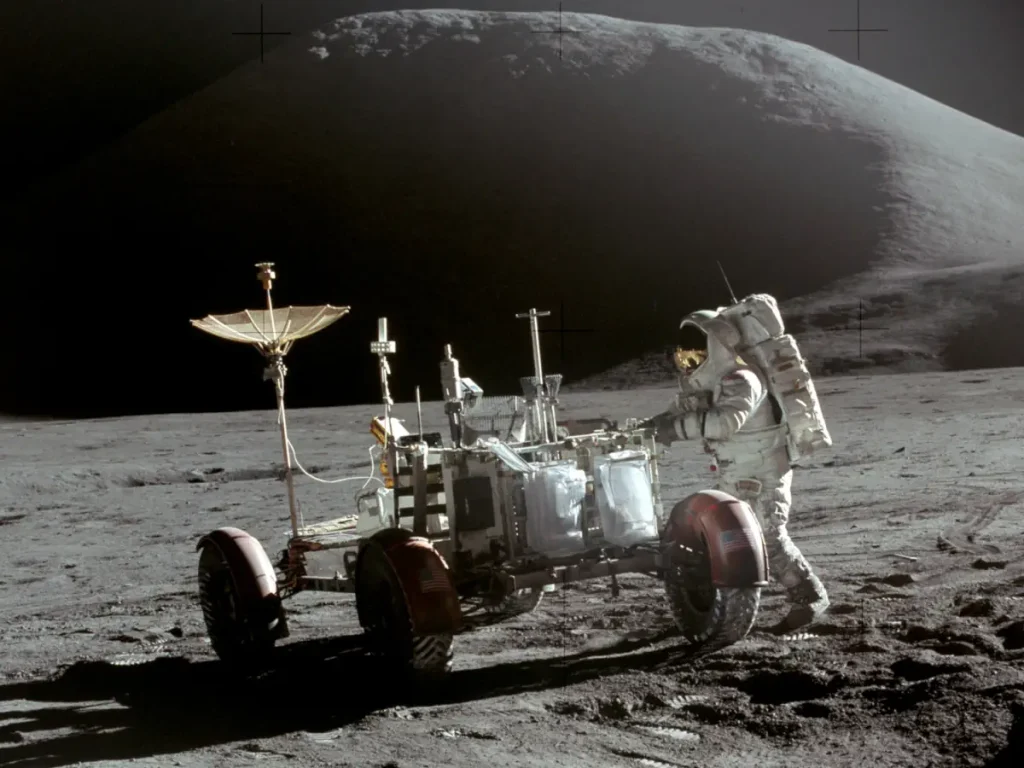
1972: $3.423 billion [$24.933 billion]
The budget of NASA is 1.48% of the 1972 Fed Budget
Major achievements:
- March 2: Pioneer 10 was launched. It was the first spacecraft to travel through the asteroid belt and make a close approach to Jupiter. Its primary mission was to gather data about Jupiter’s atmosphere, moons, and magnetic field. It sent back valuable images and scientific information, greatly enhancing our understanding of the Jovian system. On June 13, 1983, it became the first spacecraft to pass beyond the orbit of Neptune. Pioneer 10 carried a gold-anodized aluminum plaque designed to communicate information about humans and Earth to any extraterrestrial life that might encounter it. Pioneer 10 sent its last signal to Earth in 2003, having traveled farther from the Sun than any previous human-made object.
- April 6: Pioneer 11 was launched. Pioneer 11’s mission significantly expanded our understanding of the outer solar system. Although NASA lost contact with the probe in 1995, it continues to drift toward the edge of our solar system.
- April 16-27: Apollo 16 mission. It was the fifth mission to land humans on the Moon with astronauts John Young (September 24, 1930 – January 5, 2018), Charles Duke (born October 3, 1935), and Ken Mattingly (March 17, 1936 – October 31, 2023) on board. Young and Duke landed in the lunar module “Orion” in the Descartes Highlands, where they conducted three moonwalks, collected nearly 211 pounds of lunar samples, and drove the Lunar Roving Vehicle for 16.83 miles (27.1 km). This mission focused on collecting samples from the lunar highlands rather than the mare (basaltic plains). Meanwhile, Mattingly orbited the Moon in the command module “Casper”, performing experiments and photographing the lunar surface.
- July 23: Landsat 1 was launched. Originally named “Earth Resources Technology Satellite 1,” it was the first in a series of U.S. satellites designed to provide repeated observations of Earth’s surface from space. It carried two primary instruments, the Return Beam Vidicon (RBV) and the Multi-Spectral Scanner (MSS), which captured images in several spectral bands. Landsat 1 significantly contributed to remote sensing science, allowing researchers to study and monitor changes in Earth’s land surface over time.
- December 7-16: Apollo 17 mission. It was the final mission of NASA’s Apollo lunar landing program. The crew consisted of Commander Eugene Cernan (March 14, 1934 – January 16, 2017), Lunar Module Pilot Harrison Schmitt (born July 3, 1935), and Command Module Pilot Ronald Evans (November 10, 1933 – April 7, 1990). Schmitt and Cernan spent about 22 hours on the lunar surface conducting three EVAs (extravehicular activities), while Evans remained in lunar orbit in the Command Module. Apollo 17 marked the first time a professional geologist, Schmitt, went to the Moon. On December 7, 1972, the crewmembers of Apollo 17 spacecraft en route to the Moon took a photo of Earth from space, at a distance of about 45,000 kilometers (28,000 miles). This image became known as “The Blue Marble“. It remains one of the most iconic photos of Earth taken from space. The mission returned to Earth with the most substantial haul of lunar samples and conducted an extensive array of in-flight experiments. Apollo 17 remains, as of 2023, the last crewed mission to the Moon.
1973: $3.312 billion [$22.732 billion]
The budget of NASA is 1.35% of the 1973 Fed Budget
Major achievements:
- May 14: Skylab was launched. It was the first space station operated by NASA and inhabited by three separate crews, Skylab 2, 3, and 4, for 171 days and was used for a wide range of scientific research experiments. Skylab had living quarters, a workshop, a solar observatory, and other systems, and it provided new insights into the effect of long-term space flight on the human body. Though it was planned to be used further, Skylab reentered the Earth’s atmosphere on July 11, 1979, due to increased solar activity (greater-than-expected solar activity heated the outer layers of Earth’s atmosphere and increased drag on Skylab), with parts falling in Western Australia and the Indian Ocean.
- May 25-June 22: Skylab 2 mission. It was the first crewed mission to the Skylab space station. Crewed by astronauts Pete Conrad (June 2, 1930 – July 8, 1999), Joseph Kerwin (born February 19, 1932), and Paul Weitz (July 25, 1932 – October 22, 2017), the mission lasted 28 days. Upon arrival, they had to conduct repairs on Skylab, which had sustained damage during launch, including a lost heat shield and a malfunctioning solar panel. The crew successfully completed these repairs, conducted scientific experiments, and acclimated to the conditions of long-duration spaceflight. Skylab 2 set a new record for the longest time spent in space and marked a significant step in the development of space station technology.
- July 28-September 25: Skylab 3 mission. Crewed by astronauts Alan Bean (March 15, 1932 – May 26, 2018), Jack Lousma (born February 29, 1936), and Owen Garriott (November 22, 1930 – April 15, 2019), the mission spanned 59 days, nearly doubling the duration record set by Skylab 2. The crew conducted various experiments, including studies on the body’s adaptation to long-duration spaceflight, solar observations, and Earth resources. However, the mission was not without challenges, as the crew encountered initial bouts of space sickness and had to respond to spacecraft equipment malfunctions. Despite these issues, Skylab 3 was considered a success in advancing space exploration.
- November 16: Skylab 4 was launched. It was the third and final crewed mission to the Skylab space station. The crew, Gerald Carr (August 22, 1932 – August 26, 2020), William Pogue (January 23, 1930 – March 3, 2014), and Edward Gibson (born November 8, 1936), spent 84 days in space, setting a new record for the longest human space mission. The crew conducted a variety of experiments in medical science, solar physics, Earth observations, and other disciplines. They also performed several spacewalks to maintain equipment and capture images of the Sun. The mission faced some initial tension over workloads and communication with ground control but ended successfully on February 8, 1974, marking the end of the Skylab program.
- December 3: Pioneer 10 performed the first Jupiter flyby in the history of space exploration.
1974: $3.255 billion [$20.110 billion]
The budget of NASA is 1.21% of the 1974 Fed Budget
Major achievements:
- April 13: Westar 1, America’s first domestic and commercially launched geostationary communications satellite was launched. It remained operational until May 1983.
- May 17: SMS-A (SMS-1), the first geosynchronous weather satellite was launched.
- September 1: Pioneer 11 performed a Jupiter flyby that brought it to within three times closer than sister space probe, Pioneer 10, coming within 42,000 km (26,000 miles) of the surface at a speed of 171,000 kph (106,254 mph) or 47.5 kilometers per second. It also sent back the first polar images of the planet.
- October 10: Westar-2, the second of the fleet of geosynchronous communications satellites called Westar was launched.
1975: $3.269 billion [$18.510 billion]
The budget of NASA is 0.98% of the 1975 Fed Budget
Major achievements:
- January 22: Landsat 2 was launched. Operated by NASA, its primary mission was to continue the Earth observation initiatives started by Landsat 1. Equipped with a multispectral scanner, it captured detailed images of the Earth’s surface, playing a pivotal role in agriculture, forestry, and land use mapping. Originally designed for a one-year mission, Landsat 2 surpassed expectations by operating until February 25, 1982, when it was decommissioned and removed from orbit.
- July 15-24: Apollo-Soyuz Test Project. It was the first international human space flight, taking place at the height of the détente between the United States and the Soviet Union. The project was specifically designed to test the compatibility of rendezvous and docking systems for American and Soviet spacecraft and to open the way for international space rescue as well as future joint missions. To carry out this mission existing American Apollo and Soviet Soyuz spacecraft were used. The Apollo spacecraft was nearly identical to the one that orbited the Moon and later carried astronauts to Skylab, while the Soyuz craft was the primary Soviet vehicle used for cosmonaut flight since its introduction in 1967. A universal docking module was designed and constructed by NASA to serve as an airlock and transfer corridor between the two craft. Astronauts Tom Stafford, Vance D. Brand, and Donald K. Slayton took off from Kennedy Space Center on July 15, to meet the already orbiting Soyuz spacecraft. Some 45 hours later the two craft rendezvoused and docked, and then Apollo and Soyuz crews conducted a variety of experiments over a two-day period. The two spacecraft remained docked for 44 hours, separated, then re-docked, separating finally a few hours later. After separation, the Apollo vehicle remained in space for an additional six days while Soyuz returned to Earth approximately 43 hours after separation. The flight was more a symbol of the lessening of tensions between the two superpowers than a significant scientific endeavor, a sharp contrast with the competition for international prestige that had fueled much of the space activities of both nations since the late 1950s. This was the last Apollo spacecraft to be flown.
- August 5: John Manke, a NASA research pilot, successfully landed the X-24B lifting body on the runway of Edwards Air Force Base. This showed that a vehicle similar to the Space Shuttle could safely land on a specific runway after returning from orbit, without needing a separate power source for landing. The lifting-body program, which ran from 1963 to 1975, included various wingless lifting vehicles like the M2-F1, M2-F2, M2-F3, HL-10, X-24A, and X-24B. It laid the groundwork for the Space Shuttle, the X-33 technology demonstrator for future reusable space vehicles, and the X-38, a prototype for a crew return vehicle from the International Space Station.
- August 20: Viking 1 was launched. It became the first successful mission to land a fully operational spacecraft on Mars in July 1976. Viking 1 sent back the first clear images of the Martian surface and conducted numerous scientific experiments, significantly advancing our understanding of the Red Planet. It operated for over six years until contact was lost in November 1982.
- September 9: Viking 2 was launched. Like its predecessor, Viking 1, it consisted of an orbiter and a lander.
- December 12: Satcom 1 communications satellite was launched.
1976: $3.671 billion [$19.656 billion]
The budget of NASA is 0.99% of the 1976 Fed Budget
Major achievements:
- June 19: Viking 1 Orbiter was inserted into Mars orbit and started taking detailed images of Mars’s surface.
- July 20: Viking 1 Lander separated from the Orbiter and touched down at Chryse Planitia, a smooth circular plain in the northern equatorial region of Mars, and became the first successful Mars lander in the history of space exploration.
- March 26: Satcom 2 communications satellite was launched.
- August 7: Viking 2 Orbiter entered into Mars orbit and started taking detailed images of Mars’s surface.
- September 3: The Viking 2 lander separated from the orbiter and touched down safely about 4,000 miles (6,460 kilometers) from the Viking 1 lander. Despite finding no clear evidence of life, Viking 2 greatly contributed to our knowledge of Mars.
1977: $4.002 billion [$20.122 billion]
The budget of NASA is 0.98% of the 1977 Fed Budget
Major achievements:
- June 16: GOES-B, the second satellite in the Geostationary Operational Environmental Satellites (GOES) program, was launched. It was part of a series of weather-monitoring satellites developed by NASA and NOAA. Positioned in geostationary orbit, GOES-B provided meteorological data to weather stations across the U.S. It was later renamed GOES-2 once operational and played a crucial role in weather forecasting, observation, and research during its active period.
- August 20: Space Shuttle Enterprise successfully made its first free flight test. A modified Boeing 747 Shuttle Carrier Aircraft carried Space Shuttle Enterprise, a prototype orbiter, during eight captive tests to determine how well the two vehicles flew together and to test some of the orbiter’s systems. The free-flight phase of the ALT program allowed shuttle pilots to explore the orbiter’s low-speed flight and landing characteristics.
- August 20: Voyager 2 was launched to study the outer planets of our solar system. Part of the Voyager program, it has provided invaluable data on Jupiter, Saturn, Uranus, and Neptune. Voyager 2 is the only spacecraft to have visited Uranus and Neptune. After its planetary flybys, it continued to interstellar space, transmitting scientific information back to Earth. The probe carries a golden record containing sounds and images representing human culture, intended as a message for any potential extraterrestrial beings
- September 5: Voyager 1 was launched. It visited Jupiter and Saturn, sending back detailed images and data. In 2012, it became the first human-made object to enter interstellar space. It continues to send data from over 15 billion miles (24 billion kilometers) from Earth (as of 2023). It also carries one of the Voyager golden records.
1978: $4.164 billion [$19.452 billion]
The budget of NASA is 0.91% of the 1978 Fed Budget
Major achievements:
- May 20: Pioneer Venus Orbiter was launched. It helped to map the planet’s surface with radar, analyze its atmosphere, and investigate the magnetic field and solar wind interactions. The orbiter sent valuable data back to Earth for over 14 years until communication was lost in 1992, significantly enhancing our understanding of our neighboring planet.
- June 16: GOES-C, later designated as GOES-3 was launched. The primary mission of the GOES satellites was to provide real-time weather observations and improve weather forecasting. It was initially used as a weather satellite, but its mission evolved over time. After the weather instruments failed in 1989, the satellite was repurposed to support communication at the South Pole, providing critical communication links for scientific research conducted there. It played a vital role in allowing data exchange between isolated Antarctic research stations and the rest of the world.
- June 27: Seasat-A was launched. It was the first Earth-orbiting satellite designed to remotely sense the Earth’s oceans. The satellite carried the first spaceborne synthetic aperture radar (SAR). Although its mission ended after just 108 days due to a failure, it provided valuable data on oceanic conditions, including wave heights and wind speeds, and paved the way for later oceanographic satellites. Its short lifespan, but pioneering technology, had a lasting impact on ocean observation.
- August 12: A joint effort by NASA and ESRO/ESA, the International Cometary Explorer was launched. It was originally part of the International Sun-Earth Explorer program. It was repurposed to study comets and became the first spacecraft to encounter a comet, passing through the tail of Comet Giacobini-Zinner in 1985. Its innovative mission provided key insights into solar wind and cometary physics.
- October 24: Nimbus 7 environmental research satellite was launched. Equipped with various instruments, including the Total Ozone Mapping Spectrometer (TOMS), it provided valuable data on weather patterns, atmospheric temperature, and ozone distribution. Its observations significantly contributed to climate studies and advanced the understanding of Earth’s atmosphere, laying the groundwork for future meteorological satellite programs.
1979: $4.380 billion [$18.388 billion]
The budget of NASA is 0.87% of the 1979 Fed Budget
Major achievements:
- January 30: The SCATHA (Spacecraft Charging At High Altitudes) satellite was launched. Also known as P78-2, the spacecraft carried twelve experiments, three provided by NASA, to collect data on high-energy solar-wind particles causing false signals from satellites by building up electrical charges on their surfaces. Military and commercial satellites in geostationary orbit over the Earth at 35,900 kilometers (22,300 miles) had been the major sufferers, the charges could effectively disable vital communications by causing equipment failure, false recording of unachieved events, or initiation of unplanned events. SCATHA would meet the greatest challenge of its planned 1-year lifetime during a solar eclipse period beginning in March when electrical charging would reach its height; Goddard Space Flight Center (GSFC) had included an electric-field detector, a pair of 50-meter antennas to be extended in opposite directions in March to form a single instrument longer than a football field.
- March 5: Voyager 1 performed a Jupiter flyby as it flew within 277,400 kilometers (172,368 miles) of the planet’s cloud tops or 348,890 km (216,790 miles) from the center of mass.
- April 2: NASA reported that 35 candidates for Space Shuttle astronaut had completed classroom instruction and moved into engineering assignments at JSC (Johnson Space Center).
- June 27: NOAA-A was launched. The satellite was later renamed NOAA-6 in orbit. It carried six devices to measure Earth’s atmosphere, surface, and cloud cover, and near-earth proton/electron flux. It would also receive, process, and relay data from balloons, free-floating buoys, and remote automatic stations. It remained operational beyond its planned mission duration (2 years) and was decommissioned on March 31, 1987.
- July 9: Voyager 2 performed a Jupiter flyby as it flew within 570,000 kilometers (350,000 miles) of the planet’s cloud tops or about 500,000 km (310,000 miles) from the center of mass.
- July 11: Pioneer 10 became the first spacecraft to cross the orbit of Uranus. The spacecraft didn’t visit Uranus, though, it was on a trajectory toward the star Aldebaran and simply crossed the average orbital distance of Uranus, which is about 1.8 billion miles (2.9 billion kilometers) from the Sun.
- August 10: Westar-3, the third of the fleet of geosynchronous communications satellites called Westar was launched.
- September 1: Pioneer 11 performed the first Saturn flyby in the history of space exploration. The spacecraft flew at a distance of 21,000 km (13,000 miles) from Saturn’s cloud tops.
Sources
- Your Guide to NASA’s Budget on the Planetary Society website
- A Chronology of Defining Events in NASA History on the NASA History website
- Budget of NASA on Wikipedia
- Skylab 3: Spacewalks and Science on the NASA website
- The Real Story of the Skylab 4 “Strike” in Space on the NASA website
- Astronautics and Aeronautics, 1979-1984 (Pdf)
- How Many Elephants are Left in the World in 2025? - August 17, 2025
- Moon Landings: All-Time List [1966-2025] - February 2, 2025
- What Is Max-Q and Why Is It Important During Rocket Launches? - January 16, 2025
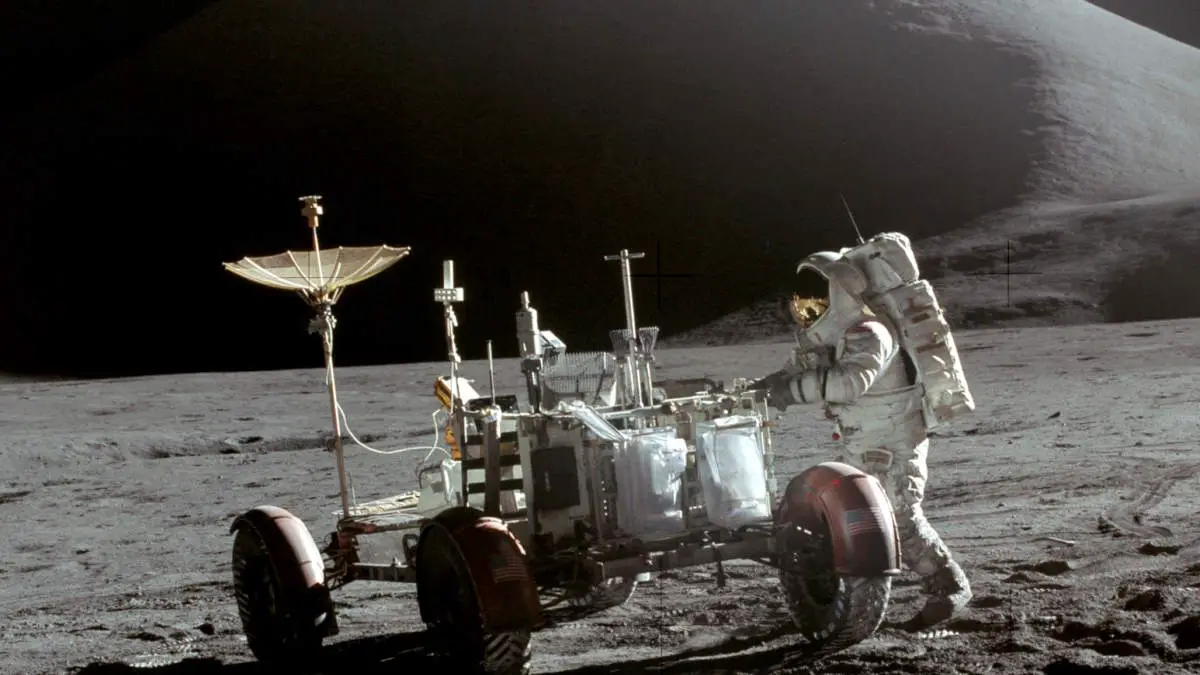
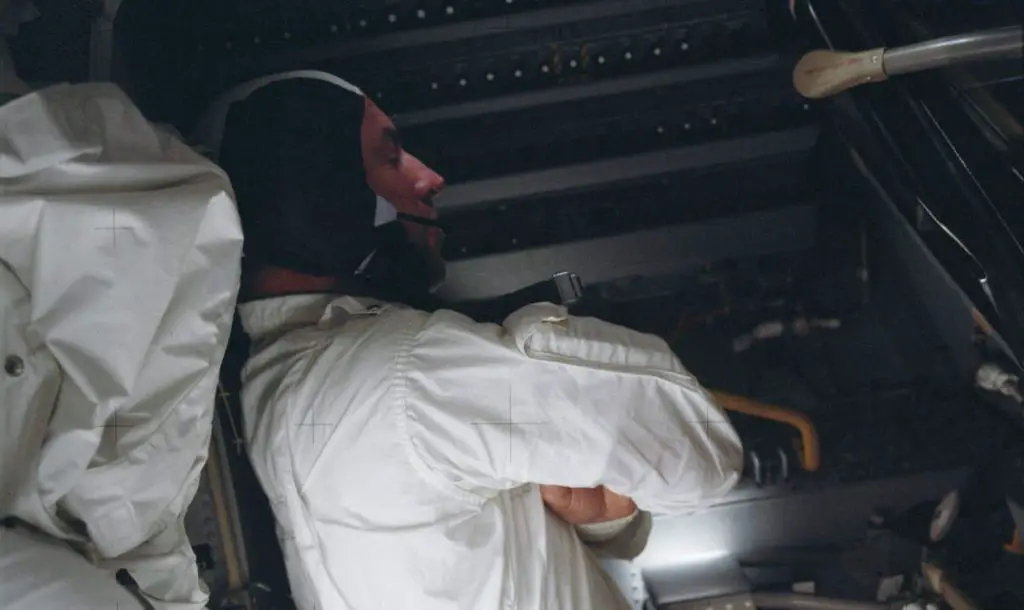
![Eugene Cernan driving the Lunar Roving Vehicle [Apollo 17]](https://ourplnt.com/wp-content/uploads/2023/12/Eugene-Cernan-Lunar-Rover-Vehicle-Apollo-17-1024x1024.webp)
